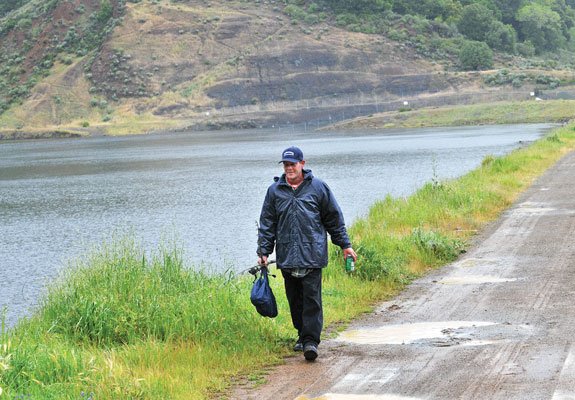The local water supply was boosted by this week’s late-season
storm, but water district officials caution that conservation
measures are still in effect as it is uncertain how much imported
water Santa Clara County will receive next year.
The local water supply was boosted by this week’s late-season storm, but water district officials caution that conservation measures are still in effect as it is uncertain how much imported water Santa Clara County will receive next year.
During the storm that started late Sunday morning and continued until early Monday evening, about 1.5 inches of rain fell on Gilroy. That was enough to add about 1,150 acre-feet of water to the 10 reservoirs owned by the Santa Clara Valley Water District, according to district spokesman Marty Grimes. That amount of water could supply about 2,300 families for one year.
“That’s a substantial increase, particularly at this time of year,” Grimes said. The 10 reservoirs’ total storage jumped from 72 to 73 percent of capacity in the same period.
By Monday morning, Uvas Reservoir west of Morgan Hill was beyond capacity, with water gushing over the spillway into Uvas Creek. Stevens Creek Reservoir in the northwestern part of the county was also overflowing Monday. The last time the two reservoirs spilled over was March 2006, Grimes said. Since then, the entire state of California has been in a drought.
The rainy season has brought about 23 inches of rain to Gilroy since October. South Santa Clara County hasn’t seen that much rain in one year since 1998, according to National Weather Service forecaster Steve Anderson. Normal rainfall for Gilroy is about 20 inches, and last season only about 13 inches fell locally.
The rain showers tapered off by Monday afternoon, and the rest of the week is expected to be partly cloudy with high temperatures in the 60s and lows in the 40s, Anderson said. Normal springtime temperatures should return to Gilroy by Saturday, with the mercury dropping again Sunday. Another storm is expected early next week, possibly starting Sunday night.
The latest rainfall was part of a “typical spring storm” that came down from the Gulf of Alaska, Anderson said. Winds Sunday reached speeds between 30 and 40 mph in the valley, and up to 60 mph on the hilltops.
Consistently clear, dry and warm days are not likely to begin until the middle of May, and residents can expect to see a few more storms until then.
Countywide conservation measures, imposed by the water district’s board of directors last year in response to the third year of a drought, are still in effect, Grimes said. Last year, the board directed residents and retailers who purchase water from the district to cut back water use by 15 percent.
By the middle of May, water district staff will present a water supply outlook for the upcoming fiscal year. By then, local officials should have heard from state and federal agencies how much water Santa Clara County will be allocated for imported water, Grimes said.
The water district relies on imported water – from the Central Valley and the Sacramento-San Joaquin Delta – for about half the local supply. The other half comes from local rainfall and natural groundwater storage.
Pumping from both outside sources is restricted by state and federal laws, and outtake from the delta has been significantly limited since 2007 in an effort to protect the endangered delta smelt fish.
“We could (continue to) have what we call a regulatory drought, where there’s plenty of water but not the ability to bring it (to local well owners),” Grimes said.














